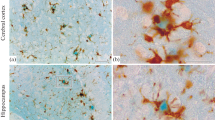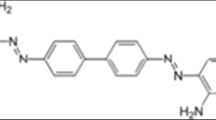Abstract
In the current protocol, we describe the Congo red staining method and a method for separately quantifying vascular and parenchymal amyloid deposits in brain tissue sections. Congo red staining detects amyloid deposits in brain tissue of amyloid precursor protein transgenic mice and human Alzheimer's tissue. It detects compacted amyloid in a β-sheet secondary structure and labels amyloid in both the brain parenchyma (amyloid plaques) and blood vessels. Congophilic amyloid in blood vessels is called cerebral amyloid angiopathy (CAA). To date, analysis of CAA has largely used a severity rating scale, including both qualitative and quantitative characteristics. Here, we describe a simple method for quantifying total Congophilic staining and resolution of this staining into the parenchymal and vascular components based on morphological criteria. It is becoming increasingly important to separately quantify various components of the Alzheimer's pathology, given the advancement of amyloid-lowering therapies into clinical trials. The entire procedure for the Congo red staining can be performed at room temperature (20–25 °C) in a fume hood. The staining protocol should take 1 h 30 min including time for coverslipping slides. Time required for image analysis depends greatly on the number of samples being analyzed and the software being used. In our hands, 30 images can be collected per hour and quantified in a further 2 h.



Similar content being viewed by others
References
Puchtler, H., Sweat, F. & Levine, M. On the binding of Congo red by amyloid. J. Histochem. Cytochem. 10, 355–364 1962.
Rensink, A.A., de Waal, R.M., Kremer, B. & Verbeek, M.M. Pathogenesis of cerebral amyloid angiopathy. Brain Res. Rev. 43, 207–223 (2003).
Grabowski, T.J., Cho, H.S., Vonsattel, J.P., Rebeck, G.W. & Greenberg, S.M. Novel amyloid precursor protein mutation in an Iowa family with dementia and severe cerebral amyloid angiopathy. Ann. Neurol. 49, 697–705 (2001).
Jellinger, K.A. & Attems, M. Prevalence and pathogenic role of cerebrovascular lesions in Alzheimer's disease. J. Neurol. Sci. 229–230, 37–41 (2005).
Wilcock, D.M. et al. Passive immunotherapy against Abeta in aged APP-transgenic mice reverses cognitive deficits and depletes parenchymal amyloid deposits in spite of increased vascular amyloid and microhemorrhage. J. Neuroinflamm. 1, 24 (2004).
Chauhan, N.B., Siegel, G.J. & Lichtor, T. Effect of age on the duration and extent of amyloid plaque reduction and microglial activation after injection of anti-Aβ antibody into the third ventricle of TgCRND8 mice. J. Neurosci. Res. 78, 732–741 (2004).
Holcomb, L. et al. Accelerated Alzheimer's-type phenotype in transgenic mice carrying both mutant amyloid precursor protein and presenilin 1 transgenes. Nat. Med. 4, 97–100 (1998).
Gordon, M.N. et al. Time course of the development of Alzheimer's-like pathology in the doubly transgenic PS1+APP mouse. Exp. Neurol. 173, 183–195 (2002).
Hsiao, K. et al. Correlative memory deficits, Abeta elevation, and amyloid plaques in transgenic mice. Science 274, 99–102 (1996).
Acknowledgements
We have been supported by NIH awards AG15490, AG18478, AG25509, AG25711 and NS48335. D.M.W. was a Benjamin Scholar in Alzheimer's Research.
Author information
Authors and Affiliations
Corresponding author
Ethics declarations
Competing interests
The authors declare no competing financial interests.
Rights and permissions
About this article
Cite this article
Wilcock, D., Gordon, M. & Morgan, D. Quantification of cerebral amyloid angiopathy and parenchymal amyloid plaques with Congo red histochemical stain. Nat Protoc 1, 1591–1595 (2006). https://doi.org/10.1038/nprot.2006.277
Published:
Issue Date:
DOI: https://doi.org/10.1038/nprot.2006.277
- Springer Nature Limited
This article is cited by
-
Neuroprotective effect of Bis(Indolyl)phenylmethane in Alzheimer’s disease rat model through inhibition of hen Lysozyme amyloid fibril-induced neurotoxicity
Journal of the Iranian Chemical Society (2023)
-
Downregulation of ATF-4 Attenuates the Endoplasmic Reticulum Stress–Mediated Neuroinflammation and Cognitive Impairment in Experimentally Induced Alzheimer’s Disease Model
Molecular Neurobiology (2023)
-
Pentoxifylline as Add-On Treatment to Donepezil in Copper Sulphate-Induced Alzheimer’s Disease-Like Neurodegeneration in Rats
Neurotoxicity Research (2023)
-
Apelin–13 protects against memory impairment and neuronal loss, Induced by Scopolamine in male rats
Metabolic Brain Disease (2022)
-
High-fat diet-induced atherosclerosis promotes neurodegeneration in the triple transgenic (3 × Tg) mouse model of Alzheimer’s disease associated with chronic platelet activation
Alzheimer's Research & Therapy (2021)





